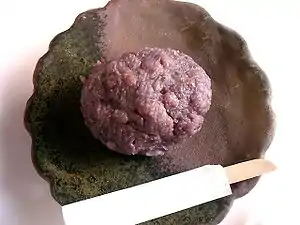Botamochi
Botamochi (ぼたもち or 牡丹餅) is a Japanese sweet made with glutinous rice, regular rice (ratio of 7:3, or only glutinous rice) and sweet azuki paste (red bean paste). They are made by soaking the rice for approximately 1 hour. The rice is then cooked, and a thick azuki paste is hand-packed around pre-formed balls of rice. Botamochi is eaten as sacred food as offering during the weeks of the spring and the autumn Higan in Japan.
 | |
| Type | Confectionery, Rice cake |
|---|---|
| Place of origin | Japan |
| Main ingredients | glutinous rice, rice, sweet red bean paste |
| Variations | Ohagi |
A very similar sweet, ohagi (おはぎ), uses a slightly different texture of azuki paste but is otherwise almost identical. It is made in autumn. Some recipe variations in both cases call for a coating of soy flour to be applied to the ohagi after the azuki paste.

The two different names are derived from the Botan (peony) which blooms in the spring and the Hagi (Japanese bush clover or Lespedeza) which blooms during autumn.
Botamochi is the modern name for the dish kaimochi (かいもち) mentioned in the Heian Period text Uji Shūi Monogatari (宇治拾遺物語).
The proverb Tana kara botamochi (棚からぼたもち), literally "a botamochi falls down from a shelf", means "receiving a windfall", "a lucky break".
The term is also used for a specific pattern of Bizen ware with two, three or five round marks, as if the marks of the small balls of rice cakes were left on the plate.[1][2] [3]
References
- "岡山県備前市 Bizen Pottery and Its Beauty -Bizen City". City.bizen.okayama.jp. Retrieved 2017-04-02.
- "備前焼の焼き色 | 備前焼じゃ". Bizenyakija.com. Retrieved 2017-04-02.
- "How To Make Anko (Red Bean Paste) • Just One Cookbook". Justonecookbook.com. 2012-03-12. Retrieved 2017-04-02.
